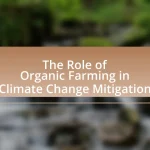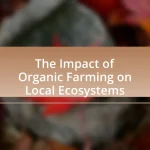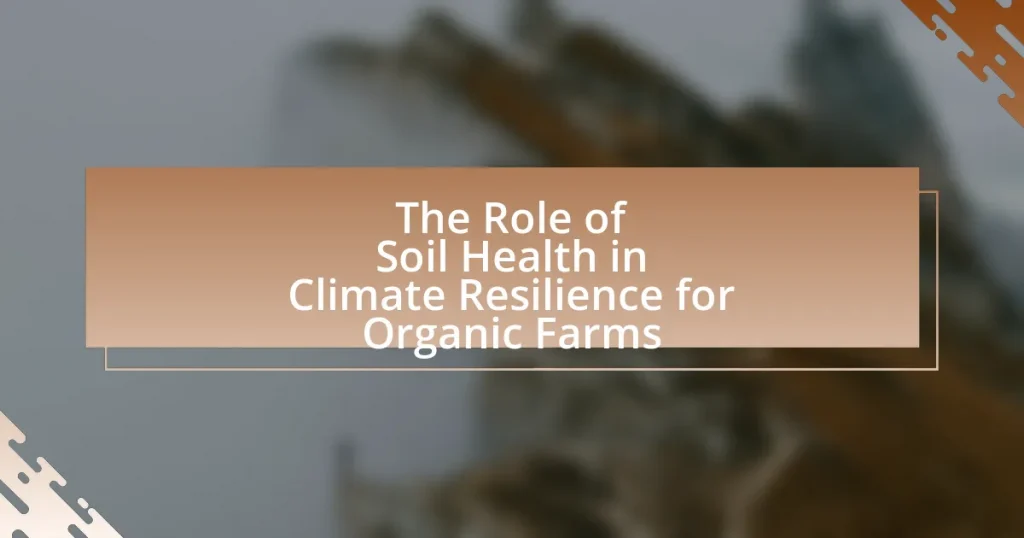Soil health plays a critical role in enhancing climate resilience for organic farms by improving moisture retention, nutrient cycling, and biodiversity. Healthy soils can better withstand extreme weather events, such as droughts and floods, while also contributing to carbon sequestration and sustainable agricultural productivity. Key indicators of soil health include organic matter content, soil structure, nutrient availability, microbial activity, and pH levels, all of which directly impact a farm’s ability to adapt to climate variability. Practices such as crop rotation, cover cropping, and composting are essential for maintaining soil health, ultimately leading to improved crop yields and reduced input costs for organic farmers.

What is the Role of Soil Health in Climate Resilience for Organic Farms?
Soil health is crucial for climate resilience in organic farms as it enhances the soil’s ability to retain moisture, improve nutrient cycling, and support biodiversity. Healthy soils can better withstand extreme weather events, such as droughts and floods, by maintaining structure and reducing erosion. Research indicates that organic farming practices, which focus on soil health, can increase soil organic matter by 1-2% annually, leading to improved water retention and carbon sequestration. This not only mitigates climate change impacts but also promotes sustainable agricultural productivity.
How does soil health impact climate resilience in organic farming?
Soil health significantly impacts climate resilience in organic farming by enhancing the soil’s ability to retain moisture, improve nutrient cycling, and support biodiversity. Healthy soils, characterized by high organic matter content and microbial activity, can better withstand extreme weather events such as droughts and floods. For instance, research indicates that organic farming practices, which focus on maintaining soil health, can increase soil organic carbon levels by 30-50%, leading to improved water retention and reduced erosion. This resilience is crucial as it allows organic farms to adapt to changing climate conditions while maintaining productivity and sustainability.
What are the key indicators of soil health?
Key indicators of soil health include soil organic matter, soil structure, nutrient availability, microbial activity, and pH levels. Soil organic matter is crucial as it enhances water retention and nutrient supply, with healthy soils typically containing 3-5% organic matter. Soil structure affects aeration and root penetration; well-structured soils promote better plant growth. Nutrient availability, particularly nitrogen, phosphorus, and potassium, is essential for plant health, with balanced nutrient levels supporting robust crop yields. Microbial activity indicates biological health, as diverse microbial communities contribute to nutrient cycling and disease suppression. Lastly, pH levels influence nutrient availability and microbial activity, with most crops thriving in a pH range of 6.0 to 7.5. These indicators collectively provide a comprehensive assessment of soil health, essential for sustainable agricultural practices.
How do these indicators relate to climate resilience?
Indicators of soil health, such as organic matter content, microbial diversity, and nutrient availability, directly relate to climate resilience by enhancing the soil’s ability to retain water, support plant growth, and withstand extreme weather events. Healthy soils improve water infiltration and retention, which mitigates flooding and drought impacts, thereby promoting agricultural sustainability. Research indicates that farms with higher soil organic matter can increase water retention by up to 20%, significantly reducing the need for irrigation during dry spells. Additionally, diverse microbial communities in healthy soils contribute to nutrient cycling, which supports crop resilience against pests and diseases, further stabilizing food production in the face of climate variability.
Why is soil health crucial for organic farming practices?
Soil health is crucial for organic farming practices because it directly influences crop productivity, nutrient availability, and ecosystem balance. Healthy soil enhances the ability of plants to access essential nutrients and water, which is vital for organic farming that relies on natural processes rather than synthetic inputs. Research indicates that healthy soils, characterized by high organic matter content and biodiversity, can improve resilience against climate variability, thus supporting sustainable agricultural practices. For instance, a study published in the journal “Agriculture, Ecosystems & Environment” by Teague et al. (2016) found that well-managed soils can sequester carbon, reduce erosion, and enhance water retention, all of which are essential for maintaining productivity in organic farming systems.
What specific practices enhance soil health in organic farms?
Specific practices that enhance soil health in organic farms include crop rotation, cover cropping, composting, and reduced tillage. Crop rotation improves soil structure and nutrient cycling by alternating different crops, which can prevent pest and disease buildup. Cover cropping, such as planting legumes, adds organic matter and enhances soil fertility while preventing erosion. Composting enriches soil with nutrients and beneficial microorganisms, promoting a healthy soil ecosystem. Reduced tillage minimizes soil disturbance, preserving soil structure and microbial habitats. These practices collectively contribute to improved soil health, which is essential for climate resilience in organic farming systems.
How do these practices contribute to overall farm sustainability?
Practices that enhance soil health contribute to overall farm sustainability by improving nutrient cycling, increasing water retention, and promoting biodiversity. Healthy soil supports robust crop growth, which leads to higher yields and reduced reliance on chemical fertilizers and pesticides. For instance, organic farming practices such as cover cropping and reduced tillage have been shown to increase soil organic matter, which enhances soil structure and fertility. Research indicates that farms employing these practices can experience up to a 30% increase in crop resilience to climate variability, thereby ensuring long-term productivity and environmental health.
What challenges do organic farms face regarding soil health and climate change?
Organic farms face significant challenges regarding soil health and climate change, primarily due to soil degradation and increased weather variability. Soil degradation, often exacerbated by intensive farming practices, leads to reduced soil fertility and structure, which directly impacts crop yields. Additionally, climate change introduces extreme weather events, such as droughts and floods, that further stress soil health by causing erosion and nutrient loss. Research indicates that organic farms, which rely on natural soil amendments and crop rotations, may struggle to maintain soil health under these changing conditions, as they often have limited access to synthetic fertilizers that can temporarily boost soil nutrients. This interplay between soil health and climate resilience is critical, as healthy soils are essential for carbon sequestration, which can mitigate climate change effects.
How does climate change affect soil composition and fertility?
Climate change significantly alters soil composition and fertility by affecting moisture levels, temperature, and organic matter decomposition. Increased temperatures can lead to accelerated microbial activity, which may deplete soil organic matter faster than it can be replenished, resulting in reduced fertility. Additionally, altered precipitation patterns can cause soil erosion and nutrient leaching, further degrading soil quality. Research indicates that regions experiencing more extreme weather events, such as droughts and heavy rainfall, face greater challenges in maintaining soil health, which is crucial for sustainable agricultural practices. For instance, a study published in “Nature Climate Change” by Smith et al. (2014) highlights that climate change can reduce crop yields by up to 30% due to its impact on soil health.
What are the consequences of poor soil health on crop yields?
Poor soil health significantly reduces crop yields. This decline occurs due to diminished nutrient availability, impaired water retention, and increased susceptibility to pests and diseases. For instance, studies show that soils with low organic matter can lead to yield reductions of up to 50% in certain crops, as nutrients are less accessible to plants. Additionally, poor soil structure can hinder root development, further limiting crop growth and productivity. Thus, maintaining soil health is crucial for optimizing agricultural output and ensuring food security.
How can organic farmers improve soil health for better climate resilience?
Organic farmers can improve soil health for better climate resilience by implementing practices such as crop rotation, cover cropping, and the use of organic amendments like compost. These practices enhance soil structure, increase organic matter, and promote biodiversity, which collectively contribute to improved soil fertility and water retention. Research indicates that healthy soils can sequester carbon, thus mitigating climate change effects; for instance, a study published in “Nature” by Lal (2020) highlights that organic farming practices can increase soil organic carbon levels by up to 30%. This increase in soil health not only supports crop productivity but also enhances the ecosystem’s ability to withstand extreme weather events, making organic farms more resilient to climate variability.
What techniques can be employed to enhance soil organic matter?
Techniques to enhance soil organic matter include cover cropping, compost application, reduced tillage, and agroforestry practices. Cover cropping involves planting specific crops during off-seasons to improve soil structure and increase organic matter through root biomass and decaying plant material. Compost application adds decomposed organic materials to the soil, enriching it with nutrients and enhancing microbial activity, which contributes to organic matter formation. Reduced tillage minimizes soil disturbance, preserving existing organic matter and promoting the accumulation of new organic materials. Agroforestry integrates trees and shrubs into agricultural landscapes, which can enhance soil organic matter through leaf litter and root contributions. Research indicates that these practices can significantly improve soil health and resilience, as evidenced by studies showing increased organic matter levels in fields employing these techniques.
How can crop rotation and cover cropping benefit soil health?
Crop rotation and cover cropping significantly enhance soil health by improving soil structure, increasing organic matter, and promoting biodiversity. Crop rotation prevents nutrient depletion by alternating crops with different nutrient requirements, which helps maintain soil fertility. For instance, legumes in rotation can fix nitrogen, enriching the soil for subsequent crops. Cover cropping, on the other hand, protects the soil from erosion, suppresses weeds, and enhances microbial activity, which contributes to nutrient cycling. Research indicates that fields with cover crops can increase soil organic carbon levels by up to 1.5 tons per hectare annually, thereby improving soil health and resilience against climate variability.

What are the benefits of maintaining soil health in organic farming?
Maintaining soil health in organic farming enhances crop productivity, improves nutrient cycling, and increases resilience to climate change. Healthy soil supports diverse microbial communities that contribute to nutrient availability and soil structure, which are essential for robust plant growth. Research indicates that organic farming practices, such as crop rotation and cover cropping, significantly improve soil organic matter, leading to better water retention and reduced erosion. For instance, a study published in the journal “Agriculture, Ecosystems & Environment” found that organic farms had 30% more soil organic carbon compared to conventional farms, demonstrating the long-term benefits of maintaining soil health in organic systems.
How does healthy soil contribute to biodiversity on organic farms?
Healthy soil enhances biodiversity on organic farms by providing a rich habitat for various organisms, including beneficial microbes, insects, and plants. This diverse ecosystem supports nutrient cycling, pest control, and pollination, which are essential for sustainable agricultural practices. Research indicates that healthy soils, characterized by high organic matter content and microbial diversity, can increase the abundance and variety of soil-dwelling organisms. For instance, a study published in the journal “Soil Biology and Biochemistry” found that organic farming practices that improve soil health lead to a 30% increase in soil biodiversity compared to conventional methods. This biodiversity not only contributes to the resilience of the farm ecosystem but also enhances crop productivity and sustainability.
What role do soil microorganisms play in ecosystem health?
Soil microorganisms are essential for ecosystem health as they facilitate nutrient cycling, enhance soil structure, and promote plant growth. These microorganisms, including bacteria, fungi, and protozoa, decompose organic matter, releasing nutrients that are vital for plant development. Research indicates that healthy soil microbial communities improve soil fertility and resilience against environmental stressors, such as drought and disease. For instance, a study published in the journal “Nature” by van der Heijden et al. (2008) highlights that diverse microbial communities contribute to increased plant productivity and ecosystem stability. Thus, soil microorganisms play a critical role in maintaining the overall health and functionality of ecosystems.
How does biodiversity in soil affect plant health and resilience?
Biodiversity in soil significantly enhances plant health and resilience by promoting nutrient cycling, improving soil structure, and increasing disease resistance. Diverse soil organisms, such as bacteria, fungi, and earthworms, contribute to the breakdown of organic matter, which releases essential nutrients for plants. For instance, a study published in the journal “Nature” found that soils with higher microbial diversity had improved nutrient availability, leading to better plant growth and health. Additionally, a diverse soil ecosystem can suppress pathogens and pests, reducing the need for chemical interventions and enhancing the overall resilience of plants to environmental stressors. This relationship underscores the critical role of soil biodiversity in supporting sustainable agricultural practices, particularly in organic farming systems.
What economic advantages does soil health provide for organic farmers?
Soil health provides significant economic advantages for organic farmers by enhancing crop yields and reducing input costs. Healthy soil improves nutrient availability and water retention, leading to higher productivity; studies show that organic farms with healthy soil can yield up to 20% more than those with degraded soil. Additionally, improved soil health reduces the need for synthetic fertilizers and pesticides, which lowers operational costs. Research indicates that organic farmers who invest in soil health practices can see a return on investment of up to 3.5 times their initial expenditure, demonstrating the financial viability of maintaining soil health.
How can improved soil health lead to reduced input costs?
Improved soil health can lead to reduced input costs by enhancing nutrient availability and water retention, which decreases the need for synthetic fertilizers and irrigation. Healthy soils, rich in organic matter and microbial activity, naturally supply essential nutrients to crops, reducing reliance on chemical inputs. Research indicates that farms with improved soil health can lower fertilizer costs by up to 30% due to increased nutrient efficiency (Source: “Soil Health and Sustainable Agriculture,” USDA, 2020). Additionally, better soil structure enhances water infiltration and retention, minimizing irrigation needs and associated costs. Thus, investing in soil health directly correlates with lower agricultural input expenses.
What is the relationship between soil health and marketability of organic produce?
Soil health directly influences the marketability of organic produce by affecting crop quality, yield, and consumer perception. Healthy soil enhances nutrient availability, improves water retention, and promotes beneficial microbial activity, which collectively lead to higher-quality produce that meets organic standards. Research indicates that organic fruits and vegetables grown in nutrient-rich, biologically active soils often exhibit superior taste, texture, and nutritional content, making them more appealing to consumers. For instance, a study published in the journal “Agriculture, Ecosystems & Environment” found that organic produce from well-managed soils had significantly higher levels of antioxidants and vitamins, which can justify premium pricing in the market. Thus, the relationship between soil health and marketability is established through the direct impact of soil conditions on the quality and appeal of organic products.
How does soil health influence water management in organic farming?
Soil health significantly influences water management in organic farming by enhancing soil structure, which improves water retention and infiltration. Healthy soils, characterized by high organic matter content and diverse microbial communities, can hold more moisture, reducing the need for irrigation and minimizing water runoff. Research indicates that organic farming practices, such as cover cropping and reduced tillage, contribute to improved soil health, leading to better water management outcomes. For instance, a study published in the journal “Agriculture, Ecosystems & Environment” found that organic soils can retain up to 30% more water compared to conventional soils, demonstrating the critical link between soil health and effective water management in organic farming systems.
What practices can enhance soil’s water retention capabilities?
Practices that can enhance soil’s water retention capabilities include the incorporation of organic matter, such as compost and mulch, and the implementation of cover cropping. Organic matter improves soil structure, increases porosity, and enhances the soil’s ability to hold moisture. Research indicates that soils enriched with organic matter can retain up to 20% more water compared to those without. Additionally, cover crops, such as clover or rye, prevent soil erosion, reduce evaporation, and improve soil health, further contributing to water retention. Studies have shown that fields with cover crops can increase water infiltration rates by 30% or more, demonstrating their effectiveness in enhancing soil’s water retention capabilities.
How does improved water management contribute to climate resilience?
Improved water management enhances climate resilience by optimizing water use efficiency and reducing vulnerability to extreme weather events. Effective water management practices, such as rainwater harvesting and efficient irrigation systems, help maintain soil moisture levels, which is crucial for crop health during droughts. According to the Food and Agriculture Organization, implementing efficient irrigation can increase crop yields by up to 50% in arid regions, thereby supporting food security in the face of climate change. Additionally, improved water management reduces runoff and soil erosion, preserving soil health and its ability to sequester carbon, further contributing to climate resilience.

What are the best practices for assessing and maintaining soil health?
The best practices for assessing and maintaining soil health include regular soil testing, implementing crop rotation, and enhancing organic matter content. Regular soil testing provides essential data on nutrient levels, pH, and microbial activity, allowing farmers to make informed decisions about amendments and management practices. Crop rotation helps prevent nutrient depletion and disrupts pest and disease cycles, promoting a balanced ecosystem. Enhancing organic matter through practices like cover cropping and composting improves soil structure, water retention, and biodiversity, which are critical for resilience against climate variability. These practices are supported by research indicating that healthy soils contribute to increased agricultural productivity and sustainability, particularly in organic farming systems.
How can farmers effectively monitor soil health over time?
Farmers can effectively monitor soil health over time by utilizing a combination of soil testing, visual assessments, and the use of technology such as sensors and data analytics. Regular soil testing provides quantitative data on nutrient levels, pH, and organic matter content, which are essential for understanding soil fertility and health. Visual assessments, including observing plant growth and soil structure, help farmers identify issues like compaction or erosion. Additionally, employing sensors to measure moisture levels and microbial activity allows for real-time monitoring, enabling farmers to make informed decisions. Research indicates that consistent soil testing and monitoring can lead to improved crop yields and sustainable farming practices, as highlighted in studies by the USDA and various agricultural universities.
What tools and methods are available for soil testing?
Soil testing can be conducted using various tools and methods, including soil probes, augers, and laboratory analysis. Soil probes allow for the collection of soil samples at different depths, while augers facilitate deeper sampling in compacted soils. Laboratory analysis typically involves chemical tests to determine nutrient levels, pH, and organic matter content, which are essential for assessing soil health. According to the USDA Natural Resources Conservation Service, regular soil testing is crucial for effective soil management and improving crop yields, thereby enhancing climate resilience in organic farming practices.
How often should soil health assessments be conducted?
Soil health assessments should be conducted at least once every three years. This frequency allows for the monitoring of soil conditions and the effectiveness of management practices over time. Research indicates that regular assessments help identify changes in soil health, which is crucial for maintaining productivity and resilience in organic farming systems. For instance, the USDA Natural Resources Conservation Service recommends this interval to ensure that farmers can adapt their practices based on the evolving health of their soil.
What are the common misconceptions about soil health in organic farming?
Common misconceptions about soil health in organic farming include the belief that organic soil is inherently fertile without management, that organic practices do not require soil testing, and that organic farming does not contribute to soil erosion. Organic soil health relies on practices such as crop rotation, cover cropping, and composting to build fertility and structure, which requires ongoing management. Additionally, soil testing is essential in organic farming to monitor nutrient levels and pH, ensuring that soil health is maintained. Contrary to the misconception, organic farming can lead to soil erosion if not managed properly, as practices like continuous cropping without cover can degrade soil structure.
How do these misconceptions impact farming practices?
Misconceptions about soil health significantly impact farming practices by leading to ineffective management strategies. For instance, the belief that soil is merely a medium for plant growth can result in farmers neglecting essential soil health indicators, such as organic matter content and microbial activity. This neglect can diminish soil fertility and resilience, ultimately reducing crop yields and increasing vulnerability to climate stressors. Research indicates that farms prioritizing soil health through practices like cover cropping and reduced tillage can enhance resilience against climate variability, demonstrating that misconceptions can hinder the adoption of beneficial practices that promote sustainable farming.
What evidence can dispel these myths?
Evidence that can dispel myths about soil health and its role in climate resilience for organic farms includes scientific studies demonstrating that healthy soils enhance water retention and reduce erosion. Research published in the journal “Agriculture, Ecosystems & Environment” by authors such as Teague et al. (2017) shows that organic farming practices, which improve soil organic matter, lead to increased soil carbon sequestration. Additionally, a study by the Rodale Institute indicates that organic farms can produce yields comparable to conventional farms while using fewer resources, thus supporting the myth that organic farming is less productive. These findings collectively illustrate that healthy soils are crucial for climate resilience, countering misconceptions about their effectiveness.
What practical steps can organic farmers take to enhance soil health?
Organic farmers can enhance soil health by implementing practices such as crop rotation, cover cropping, and composting. Crop rotation prevents nutrient depletion and disrupts pest cycles, leading to healthier soil ecosystems. Cover cropping, which involves planting specific crops during off-seasons, improves soil structure, increases organic matter, and enhances nutrient availability. Composting adds essential nutrients and beneficial microorganisms to the soil, promoting microbial diversity and improving soil fertility. Research indicates that these practices can significantly increase soil organic carbon levels, which is crucial for soil health and climate resilience.
What are the top strategies for improving soil fertility?
The top strategies for improving soil fertility include the use of organic matter, crop rotation, cover cropping, and soil testing. Organic matter, such as compost and manure, enhances soil structure and nutrient content, leading to improved fertility. Crop rotation prevents nutrient depletion and reduces pest and disease cycles, thereby maintaining soil health. Cover cropping protects the soil from erosion and adds organic matter when the crops are terminated. Soil testing provides essential information on nutrient levels and pH, allowing for targeted amendments to optimize fertility. These strategies are supported by research indicating that organic matter can increase soil fertility by up to 30% and that crop rotation can enhance yields by 10-20% in various agricultural systems.
How can farmers implement sustainable practices effectively?
Farmers can implement sustainable practices effectively by adopting regenerative agriculture techniques that enhance soil health. These techniques include crop rotation, cover cropping, and reduced tillage, which improve soil structure, increase organic matter, and promote biodiversity. Research indicates that regenerative practices can lead to a 30% increase in soil organic carbon, which is crucial for climate resilience. Additionally, integrating livestock into crop systems can enhance nutrient cycling and reduce reliance on synthetic fertilizers. Studies show that farms employing these methods can achieve higher yields while minimizing environmental impact, thus demonstrating the effectiveness of sustainable practices in organic farming.










